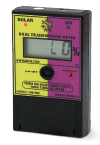- FE News»
- PPS News»
- Oct. 31, 2024
- [News Release R-1020] Release of "ECHELON Zen-Xero DYNAMIX”
- May. 15, 2024
- [News Release R-1019] Release of "ECHELON Ver.3.0”
- Oct. 02, 2023
- [News Release R-1018]Compound that achieves a genuine finish Full Renewal of “KATANA” Series
- Jun. 27, 2023
- [News Release] A final finishing compound that achieves a beautiful wet gloss. "KATANA DARK-SHOT" is Released.
- May. 22, 2023
- [News Release] Full renewal of buffing pad category Brand integrated into HAYABUSA
Automotive Films
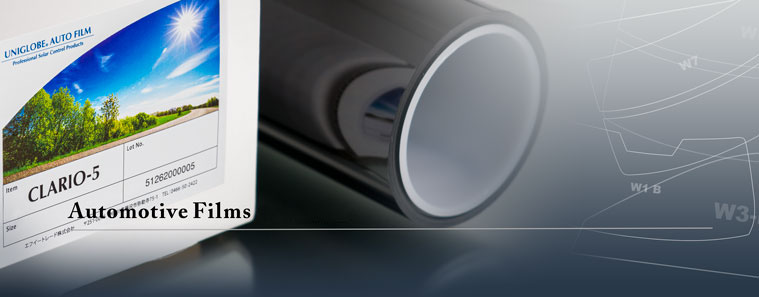
Automotive film softens light and blocks ultraviolet rays and heat. Installation of automotive film is an important part of car detailing services. Automotive film is indispensable for creating a comfortable space inside the vehicle.
Light

Automotive film softens or reflects light. But what is light, exactly? Normally, "light" refers to light that you can see (visible light), but there are also types of light invisible to the human eye. Insects have a different visible range than humans, and can see light with wavelengths that are invisible to humans.
Electromagnetic waves

Visible light is a small part of the spectrum of electromagnetic waves. Electromagnetic waves are divided into gamma rays, x-rays, ultraviolet rays, visible rays, near infrared rays, far infrared rays and radio waves depending on which wavelength range they fall into.
Visible light (range visible to the human eye)

Visible light consists of electromagnetic waves with wavelengths visible to the human eye. The range of wavelengths in the electromagnetic spectrum that corresponds to visible light is about 380nm–770nm, but strictly speaking, it can vary between people. Light with a short wavelength around 380nm appears bluish-purple, while light with a long wavelength around 770nm appears red. Applying automotive film to a window decreases the transmittance of visible light. The darker the color, the lower the visible light transmittance.
About enforcement of the revision of the Road Transport Vehicle Act
A revision of the Road Transport Vehicle Act came into force on April 1st, 2003. Representative examples of prohibited modifications specified in the safety standards include installation of tinted film that obstructs the driver's vision, cutting the muffler, installation of a prohibited muffler, significantly raising or lowering the vehicle's height, and installation of wide tires that protrude from the vehicle's body.
The revisions can be summarized as follows.
1. Prohibition of the act of making modifications that do not comply with safety standards in itself
2. Strengthening of the system for ordering that illegally modified vehicles be properly maintained
Under the revised law, not only are vehicles with prohibited modifications deemed to be inadequately maintained, the act of making those modifications itself is prohibited. (The penalty is imprisonment of 6 months or less, or a fine of 300,000 yen or less.) Vehicles deemed to be inadequately maintained are given an "illegally modified vehicle" sticker, with orders that the vehicle receive maintenance. The vehicle must be brought to an office of the Department of Transportation for inspection within 15 days of the maintenance. The system for ordering maintenance was also further strengthened under the law. Now, if the sticker is removed or the order is not complied with, use of the vehicle may be prohibited for up to 6 months, and the automobile inspection certificate and license plate may be confiscated. Mechanics who violate the standards may also be punished.
There are regulations on automotive films.
Because the visible light transmittance of automotive films is regulated by the Safety Standards for Road Vehicles (Ministry of Land, Infrastructure, Transport and Tourism), not every type of film is acceptable. The windshield, driver's side window and passenger's side window must have a visible light transmittance of 70% or higher. The visible light transmittance is measured with the film applied to the glass. The visible light transmittance of a particular film can vary depending on the type of glass. In general, even colorless and transparent glass has a visible light transmittance of at most 85–90%.

The windshield, driver's side window and passenger's side window must have a visible light transmittance of 70% or higher.
Measurement of visible light transmittance
Visible light transmittance can be measured using a dedicated measuring instrument like TINT METER or ADVANCED LIGHT TRANSMITTANCE METER. Visible light transmittance after film installation varies depending on the combination of glass and film. We recommend using a dedicated measuring instrument to check it. (The measuring instrument's reading is not guaranteed to match the result of a vehicle inspection.)
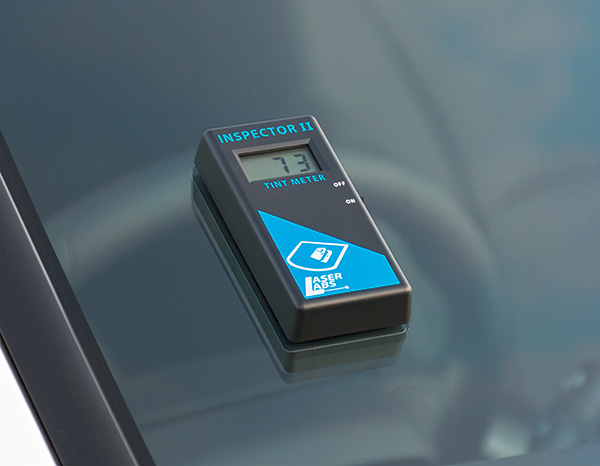
TINT METER M2000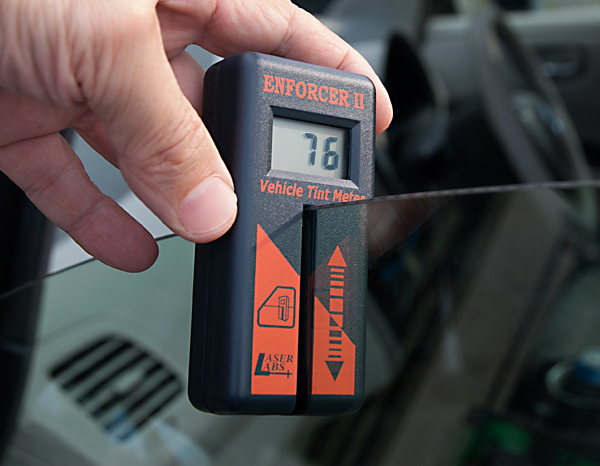
TINT METER M1000-

TINT METER M100 -

ADVANCED LIGHT
TRANSMITTANCE METER
UV Ultraviolet Rays

Ultraviolet rays have a shorter wavelength than even bluish-purple visible light, ranging from 10 to 400nm. Below that are X-rays. UV rays can be classified into UV-A, UV-B and UV-C. UV-C is very harmful, but is absorbed by the ozone layer before it reaches the surface. UV-B affects the skin and eyes, causing photodermatitis, solar keratosis, photokeratitis and so on. Prolonged exposure may cause skin cancer and cataracts. Exposure to UV-A ages the skin by denaturing its proteins. Ultraviolet rays can also cause discoloration of material inside vehicles or rooms.
Automotive film is highly effective at blocking harmful UV rays. At present, most professional-oriented films block at least 99% of UV rays. 3mm-thick clear float glass has a UV transmittance of about 65%, allowing the majority of ultraviolet rays (UV-A) to pass through, but installing a film blocks the vast majority.
Measurement of UV transmittance
Ultraviolet rays are invisible. No matter how effective the film is at blocking UV rays, that effectiveness cannot be demonstrated with the film alone. Using a measuring instrument like the UV TRANSMISSION METER, SOLAR & UV TRANSMISSION METER, or UV TRANSMISSION & POWER METER to measure the UV transmittance is highly effective for demonstrating the blocking effect to customers. The card type UV Intensity Meter can also be used to easily visualize the UV intensity, making it highly effective for appealing to customers.
-
* Solar energy
transmittance can also be measured. -
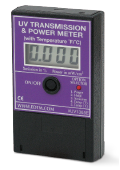
UV
TRANSMISSION &
POWER METER -
* UV intensity (mW/cm2)
and air temperature (℃/°F) can also be measured. -

UV light pen
A UV light pen, which emits UV rays, can also be used to demonstrate UV blocking efficacy. It can be used in conjunction with any UV meter.

Infrared Rays
Infrared rays have a longer wavelength than even red visible light, ranging from 700nm to 1000μm. Above that are radio waves. Infrared rays can be classified as near infrared, mid infrared, or far infrared. Near infrared rays are between 700nm and 2μm. They are used for television remote controls and similar applications. Mid infrared rays are between 2 and 4μm. Far infrared rays are between 4μm and 1000μm. Far infrared rays are a source of heat. They are used for heating and cooking equipment. Blocking the far infrared range is an effective way to block the sun's heat.
Heat Blocking Effects
Measurement of solar energy transmittance
Infrared transmittance and thermal energy transmittance are not the same. To determine the heat blocking performance of a film, you need to measure its transmittance of solar energy as a whole. The SOLAR & UV TRANSMISSION METER can instantly measure both UV transmittance and solar energy transmittance.
Shading coefficient
The shading coefficient can be used to compare the heat blocking performance of different films. The shading coefficient is a value that indicates how much heat passes through glass with film applied, relative to how much heat passes through a 3mm sheet of float glass. A value of "1.00" is equivalent to how much heat passes through the float glass. For example, UNIGLOBE AUTO FILM's USG-05CR has a shading coefficient of 0.69, which means that it lets through 69% of the heat that would be let through by a 3mm sheet of glass without film (blocking 31% of heat). The smaller the number, the better the heat blocking performance. However, a slight difference of 0.0x or so probably cannot be felt.

Catalog specifications
Our automotive film catalog contains a variety of product specifications.
| Film thickness | Mainly displayed in μm (micrometer) units. 1μm is 1/1000th of 1mm. 1 mil is 1/1000th of an inch (about 25 microns). |
|---|---|
| Visible light transmittance | The transmittance of visible light (light that is visible to the eye). Normally indicated as a percentage. |
| UV transmittance | The transmittance of ultraviolet (UV) rays. Normally indicated as a percentage. |
| Solar energy transmittance/absorptance/reflectance | The transmittance, absorptance and reflectance of thermal energy from the sun. Normally indicated as a percentage. Because the sum of transmittance, absorptivity and reflectance is always 100%, the reflectance can be determined if the transmittance and absorptivity are known. |
| Thermal transmittance | When there is a temperature difference between two sides of the glass, heat is gradually transferred from the side with the higher temperature to the side with the lower temperature, eventually reaching equilibrium. Thermal transmittance indicates the ease with which heat is transmitted under certain conditions. The lower the value, the more difficult it is for heat to be transferred (higher heat blocking performance). The measurements shows the amount of heat transferred per square meter in an hour, under the following conditions: wind speed of 24km/h, indoor temperature of 20℃, outdoor temperature of 7℃ and no solar radiation. |
| Shading coefficient | A relative value, with "1" equivalent to the amount of solar heat that passes through a 3mm thick sheet of float glass. It is an easy-to-understand indicator of the heat blocking performance of a film. |
